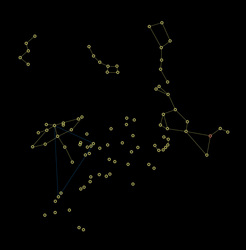|
_Now Available in E-Book and Paperback! If you haven't already, please start by reading Lesson 1: The North Star, Lesson 2: The Circumpolar Constellations, Lesson 3: Elegant Orion, and Lesson 4: Ask Orion for Directions before proceeding. If you've been practicing along with the real sky, you'll need to wait 6 months between Lesson 4 and Lesson 5. Sorry about that. It's summer now, for the purposes of our continuing stargazing education. Most diagrams in this lesson will show both the whole picture (so you can remember where you are), and a zoomed in version so you can see what's going on better. Start by orienting yourself. Find the Big Dipper, then Polaris, confirm Cassiopeia. I've left out Cepheus and Draco, because they're harder to find in the real sky anyway. If you want to quiz yourself a bit more, add them in where you think they should be in your mind, then check yourself by going back to Lesson 2. Boötes, the Herdsman: The Herdsman, Boötes (boo-OH-tees), contains one of my favorite stars to find. It's another red star called Arcturus (arc-TER-us). Find it using the Big Dipper; follow the arc of the handle to get to Arcturus. That red star is the brightest one you'll find in Boötes. Corona Borealis, the Northern Crown: I usually just call this one "Corona" because I've never seen Corona Australis, the Southern Crown. Find Corona by rolling an imaginary bouncy ball off the handle of the big dipper. The ball will hit Arcturus, and then bounce back up to land in Corona. Corona forms a "C" shape (C is for Corona, or C is for Crown, take your pick), and it is oriented like a cup to catch the bouncy ball. The Summer Triangle: A well-known asterism, the Summer Triangle is actually 3 bright stars from 3 different constellations. To find this one, widen your gaze a bit. The Summer Triangle is quite large. Find 3 bright stars high overhead (in the middle of the summer at prime star-watching time, it's pretty much directly above you) that form a triangle the same shape as the blue one below. For orientation purposes, notice that the skinny end points away from the line formed by connecting the Big Dipper, the Little Dipper, and Cassiopeia. Remember that in my diagrams, there are no distinctions between bright stars and faint stars. The points of the Summer Triangle in the real sky will be brighter than anything else around them; those three stars are the 2nd (Vega), 7th (Altair), and 14th (Deneb) brightest stars in our night sky. It should be fairly easy to pick them out. (Other stars in the top 15 we've already learned about: Sirius, Arcturus, Rigel, Procyon, Betelgeuse, Aldebaran, and Pollux). Cygnus, the Swan: The point of the Summer Triangle closest to Cassiopeia is the star Deneb, in the constellation Cygnus (SIG-nus). Deneb is the tail of the swan, and the swan flies toward the triangle. An asterism within the swan is the Northern Cross. The Southern Cross, visible in the southern hemisphere, "points" south the same way our Big Dipper "points" north. Lyra, the Lyre: Completing the short side of the Summer Triangle is the star Vega (VAY-guh), in the constellation Lyra (LEE-rah). A Lyre is a stringed musical instrument, kind of like a harp. Aquila, the Eagle: Completing our Summer Triangle is the star Altair (ahl-TARE), in the constellation Aquila (uh-KWIL-uh). Altair is one of the stars in the head of the eagle, and the beak of the eagle faces away from the triangle. Hercules, the Hero: Nestled between Corona and the Summer Triangle is Hercules (HUR-kyoo-leez). He holds a club above his head, and runs across the summer sky. Hercules can be tricky to discern, as he is composed of faint stars, but once you can narrow down the region of sky by finding Corona and the Summer Triangle, you might as well see if you can pick him out.  The Milky Way: If you're in a really dark area, with no moon, and far away from city lights, the Milky Way will be easy to find. Otherwise, knowing exactly where to look can help you out. The Milky Way runs through Cassiopeia and Cygnus. If you can see those two constellations, look carefully and see if you can find it. What is the Milky Way? It's our galaxy, and you're seeing it from the inside. Our galaxy is shaped like a giant frisbee in space. Imagine you are a tiny ant wandering through a frisbee factory. Suddenly, you fall into a vat of clear-blue molten plastic, and you get manufactured into a frisbee. When you look up through of the top of the frisbee, you can see a few molecules of clearish blue plastic (stars) before you see the outside world (space). If you look down through the bottom of the frisbee, you can also see a few molecules of plastic before you see the outside world. If, however, you try to look sideways through the frisbee, there's so much plastic in the way, that all you see is bluish plastic. When you see the Milky Way in the sky, it looks like a dense stripe of stars - you're looking sideways through the disk of the galaxy from inside it! The term "Milky Way" comes from the Greek word for "galaxy" (galaxy = galactic = lactic = lactose = milk, right?). With enough visible stars, the Milky Way certainly looks like someone spilled milk across the sky. Comments are closed.
|
Topics
All
Archives
May 2021
|
HOME |
PHOTOGRAPHY COLLECTIONS
|
© COPYRIGHT 2020. ALL RIGHTS RESERVED.
|





















 RSS Feed
RSS Feed

